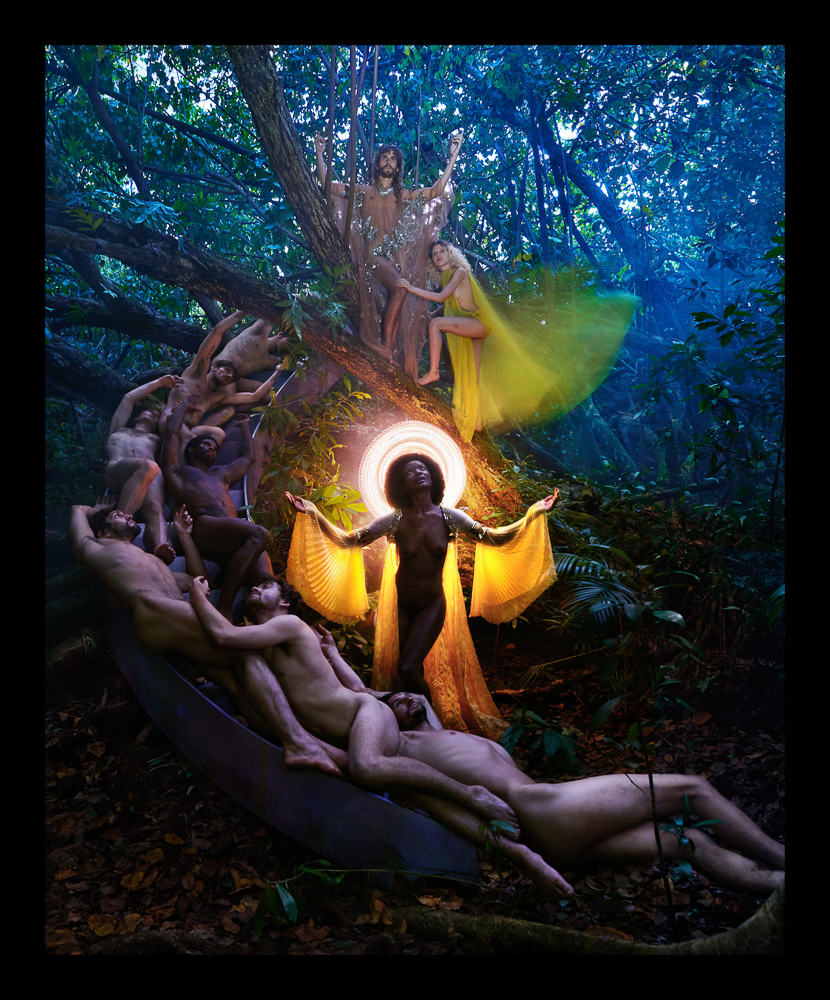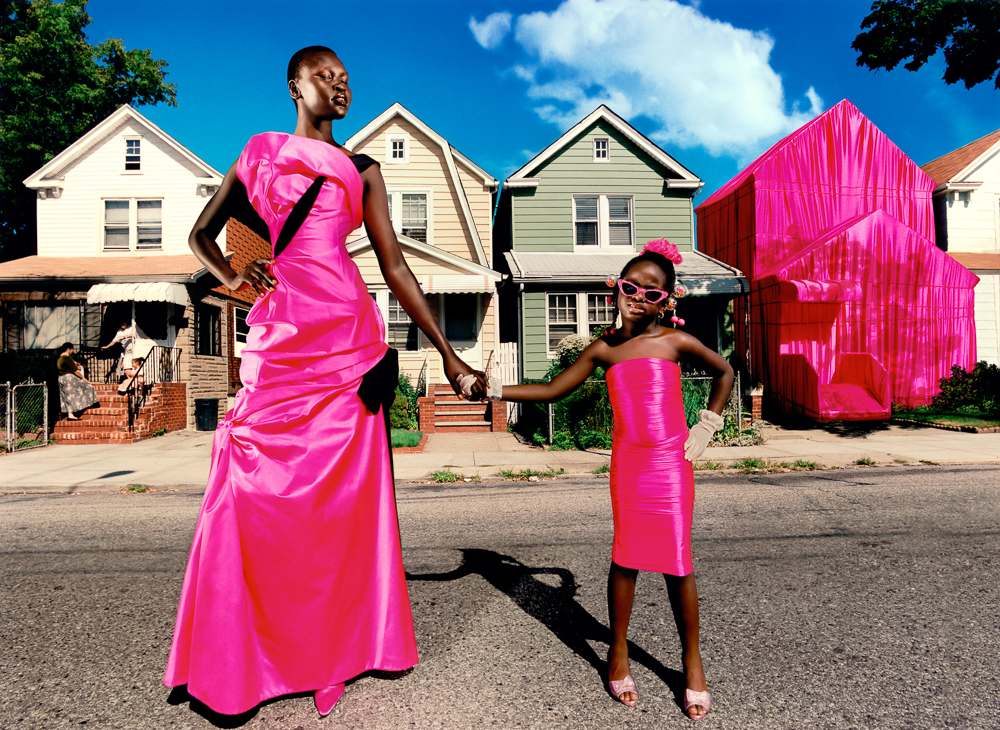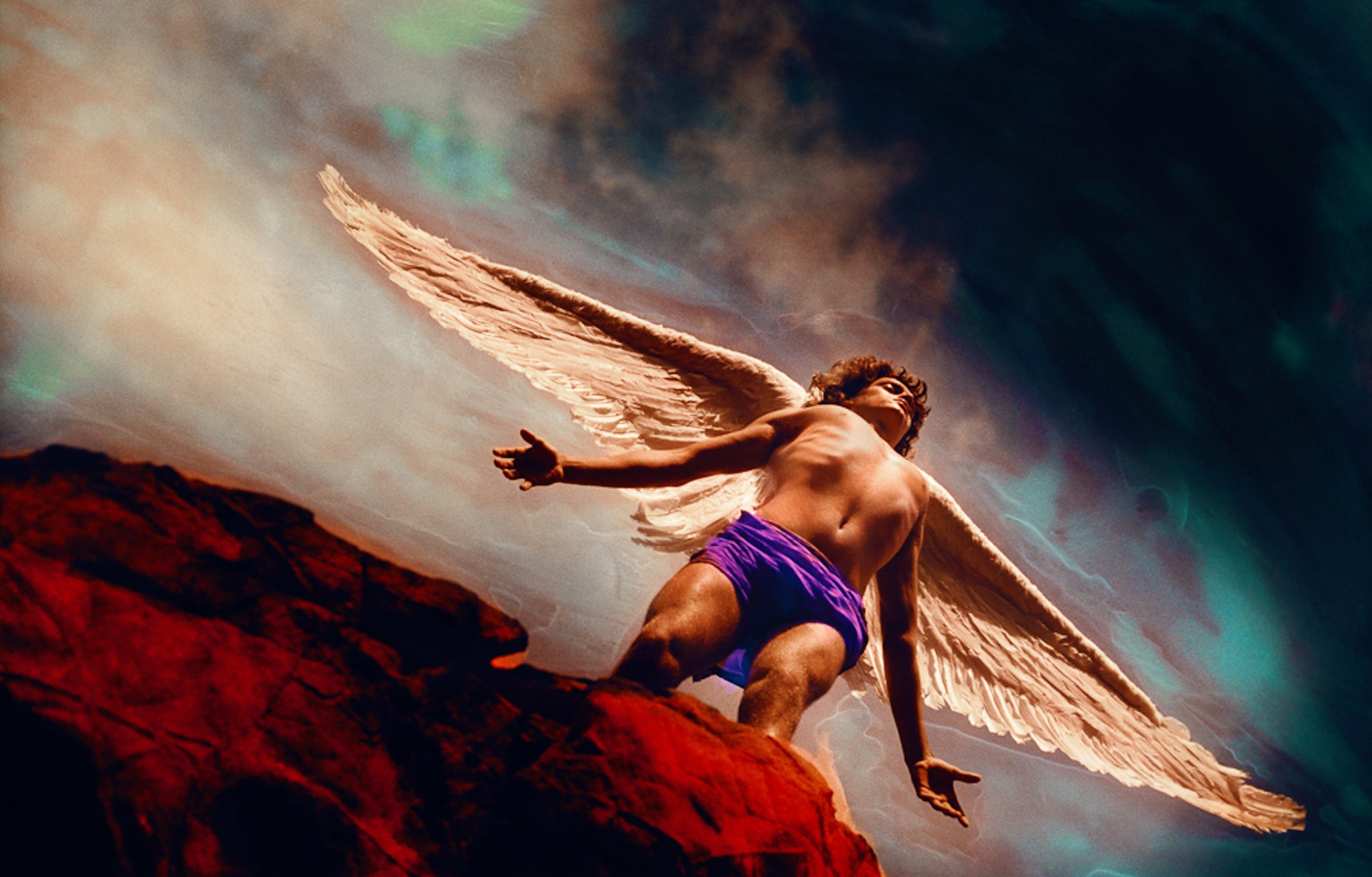If David LaChapelle could save one artwork from his upcoming show, Make Believe, at New York’s Fotografiska — just around the corner from the East Village loft where he held his first exhibition in the mid-80s — he’d pick “Deluge” (2006). A 40-inch-wide tableau inspired by Michelangelo’s frescoes on the Sistine Chapel ceiling, it renders an apocalyptic rapture in characteristically camp style. Sculpted men and voluptuous women clamour from a rising flood, arms stretched to the heavens as symbols of the modern world — Starbucks, Burger King, Gucci and a Caesar’s Palace — crumble into the water. It’s hard not to interpret a foreboding message of capitalism gone too far or a collective moral failure ushering in these end times and, 16 years after making the image, both are sentiments David comes back to multiple times in our conversation.
Talking over a patchy WhatsApp call from Hawaii, the legendary photographer effuses about the peacefulness of a life spent on his incredibly remote East Maui estate with bad wifi, as well as the eco-conscious restoration that went into making this former nudist colony self-sufficient. Laterally, he also takes great umbrage at the changing nature of popular culture and the world outside the parameters of this compound. Focusing much of his ire on the trappings of millennial-Gen Z life — TikTok, “WAP“, brands, brand partnerships, and the steady decline of incendiary artistic movements — rather than any of the innovative ways this generation has scaled such a challenging period, David has a tendency to sound like a Generation Xer out of step with the world.

“We don’t have any movements in art; there’s no big movement like pop art or graffiti out happening on the street; it’s gone,” he says. David believes the reasons are multifold, and while he fairly points out that corporate greed has a role to play — “the corporatisation of new music”, for example, means “people can’t make music off of albums anymore, so they have to find other ways to live that rockstar lifestyle” — he also finds fault in the psyche of young people. TikTok is “fucking hypnotism basically”, he says, “degrading everyone who gets on it to the point where their attention span is like… a goldfish. There’s a scientific paper which came out [that] said it’s bringing people’s attention span down to that of a goldfish. And they weren’t being facetious.”
Meanwhile, street style has also lost its sparkle; an obsession with logos ushering in the death of individuality. “When I was a kid growing up […] in the East Village, it was about the style that you had that was different from everybody else’s, it wasn’t just going, ‘I’m going to spend a lot of money on a pair of shoes that I can’t afford, $700 on a pair of rubber boots, that make me look like a duck so that everyone knows I spent $700 on a pair of boots that make me look like a rubber duck’, you know? It’s kind of crazy, and I’m just waiting for this to end.”
![1986 - David LaChapelle - 'Andy Warhol[colon] Last Sitting' (1986, New York) - (CREDIT LINE - ©David LaChapelle, courtesy of Fotografiska New York).jpg](https://i-d.co/wp-content/uploads/2024/05/1661886638877-1986-david-lachapelle-andy-warholcolon-last-sitting-1986-new-york-credit-line-cdavid-lachapelle-courtesy-of-fotografiska-new-york.jpeg?quality=90&w=758)
Still, few people are as qualified as David to make such sweeping judgements about the changing nature of fame, pop, artifice, money, the art world, and so forth, and Make Believe — comprising 150 works from the past 40 years arranged over six floors — certainly forces you to listen. He’s one of our great archivers of celebrity, arriving in New York at a critical moment in the genesis of the modern star, the early 80s, and landing a job as a busboy at Studio 54 before becoming a protégé of Andy Warhol at Interview. In the years since, his magazine covers, album artworks and music videos have ascended beyond passing trends — particularly the grunge, black-and-white look of the 90s — capturing Michael Jackson, Britney Spears, Angelina Jolie, Eminem, Tupac, Aaliyah, Hillary Clinton, and even his mentor Andy, before he passed, with the same irreverent charm and humour as today.
Back to the question of whether it’s a race to the bottom in popular culture, I question whether the seeming absence of any ‘big movements’ in art or music might be down to the death of a monoculture (an era when hundreds of millions of Americans would often tune into one of a handful of TV stations to see the same award show, music video premiere or tell-all interview). David disagrees: “I don’t think that’s true,” he says. Instead, he sees a growing separation between artists and society. “I don’t think they’re making music that touches the nerve of what’s happening.”
![David LaChapelle - detail of 'Vox Populi' wheatpaste poster installation - 'Tupac[colon] Becoming Clean' (1996, Los Angeles) - (CREDIT LINE - ©David LaChapelle, courtesy of Fotografiska New York).jpg](https://i-d.co/wp-content/uploads/2024/05/1661886655232-david-lachapelle-detail-of-vox-populi-wheatpaste-poster-installation-tupaccolon-becoming-clean-1996-los-angeles-credit-line-cdavid-lachapelle-courtesy-of-fotografiska-new-york.jpeg?quality=90&w=724)
Much to his chagrin, what we have now in place of Vietnam protest songs, is Cardi B and Megan thee Stallion‘s “WAP”. “We have so much going on today, so much confusion. We don’t have anybody singing about it. You have ‘Wet Ass Pussy’; that’s what matters. ‘Wet Ass Pussy’ matters. And NPR is like, ‘Wet Ass Pussy’ number one song. Who wants their kids listening to that? I mean, seriously, there’s always been the adult element to music; I was dancing to it as hard as anybody else in the clubs in New York, but it was for adults, it wasn’t pop music, it wasn’t on the radio, it was in clubs for adults. We had ‘My neck, my back, my pussy and my crack’, and we’d all be dancing, but it wasn’t playing on public radio.”
Khia’s “My Neck, My Back (Lick It)”, a song that was admittedly bigger here in the UK than in the US when it was released in 2001 (reaching number 4 on the UK charts), did, however, play on mainstream radio and, from personal experience, was a school playground anthem. A censored version was released to airwaves in the US, just as now. So the moral panic around a song like “WAP” feels misplaced. Yet a religious morality does continue to underpin the conversation in a way that might be unexpected to a casual observer of his work. Christianity has often fed into David’s imagery, but this is, after all, a photographer who shot a naked Eminem holding nothing but a stick of dynamite to cover his modesty; a 19-year-old Paris Hilton, in a see-through tank top, middle finger up in her grandparents’ $60 million estate; who made a star out of Amanda Lepore, one of the most prominent transgender women of the 90s, when positive attitudes around transness were far from mainstream and religious conservatism prevailed.

When asked if it’s still possible to be controversial in photography, David says he never intended to be such a thing, and that we also don’t live in “a shockable society anymore”, once again returning to a position of concern for the soul of the present world. “People that think what’s shocking it’s just not shocking because we’ve all seen so much. Usually they go dark, dark road… hyper-sexuality, or like really, or just show something bloody, you know. You’ve seen that a lot in fashion, and it’s not shocking anybody. It’s just banal at this point because we don’t live in a shockable society, we’ve seen actual beheadings on the internet, that was one of the most downloaded things in the history of the internet, I wouldn’t look at it because I wouldn’t want that in my head ever, you know, but the shit that people see on TV now, like on a regular basis on the news every night, what could be more shocking than that.”
David continues to shoot popstars, despite what the headline of a Guardian article published in 2017 suggested – that he reached a point where he never wanted to shoot another popstar again. The quote simply didn’t convey any of the humour he intended. “They made that the pull quote, and I was just joking when I said it. I was joking around. I was like, ‘Oh god, I don’t wanna shoot another popstar’ because I was just talking about how difficult it was working sometimes with everybody in the entourages, and the record labels, and the publicists and the hanger on-ers, and it just got to be a little crazy and stuff. But, you know, it was really made much more hyperbolic than it really was meant.”
![David LaChapelle - detail of 'Vox Populi' wheatpaste poster installation - 'Travis Scott[colon] Tears' (2020, Los Angeles) - (CREDIT LINE - ©David LaChapelle, courtesy of Fotografiska New York).jpg](https://i-d.co/wp-content/uploads/2024/05/1661886706547-david-lachapelle-detail-of-vox-populi-wheatpaste-poster-installation-travis-scottcolon-tears-2020-los-angeles-credit-line-cdavid-lachapelle-courtesy-of-fotografiska-new-york.jpeg?quality=90&w=767)
He does, however, stand by his comments in a more recent interview that a celebrity referring to themselves as a brand is a terrible indictment of our time. “I just don’t like the idea that people are brands,” he says. “I know I’m not going to have anything in common with them. You know what I mean? When people refer to themselves as a brand, I just tune out.” Painting a very familiar image, he describes a modern archetype of a star: “You have your Kardashian girlfriend, and you have your Instagram and your social media accounts that you have to oversee that. And then you have your sneaker deal and your McDonald’s deal, and you have your… all this extra stuff. And you design a new collection for so and so. Music becomes this tiny piece. You’re like Target, and then your music is the linen department, a very small part of that brand. That’s why we don’t have a Beatles, or a Rolling Stones, or Aretha Franklin, Stevie Wonder, Prince, Michael Jackson.”
I comment that it sounds a lot like Travis Scott, who he’s worked with multiple times, including shooting Travis’s controversial ASTROWORLD album cover. He brushes it off: “It sounds like a lot of people.”
![2009 - David LaChapelle - 'Archangel Michael[colon] And No Message Could Have Been Any Clearer' (2009, Hawaii) - (CREDIT LINE - ©David LaChapelle, courtesy of Fotografiska New York).jpg](https://i-d.co/wp-content/uploads/2024/05/1661887792185-2009-david-lachapelle-archangel-michaelcolon-and-no-message-could-have-been-any-clearer-2009-hawaii-credit-line-cdavid-lachapelle-courtesy-of-fotografiska-new-york.jpeg?quality=90&w=750)
Now that the sacred bond that a photographer once enabled between star and fan (or at least consumer) has changed — social media redefining the access, blah blah blah — I ask David whether his views on fame more abstractly have changed over the past 40 years. But, contemplatively, he says that fame has always moved with the times: “People still have a desire, like they always have, for celebrity. Botticelli was painting Simonetta Vespucci, who was a famous beauty of her time in Italy… every civilisation had their aristocrats, their famous people, their famous beauties, I think that’s just a human thing, so it’s just evolved.”
Whoever you consider the Simonetta Vespucci of today to be, it’s very likely David LaChapelle has shot her. And 800 years from now those images, and the many others that Make Believe comprises, could well be the prevailing documents of what fame meant to all of us at this point in history, much like Botticelli’s do now. And as an apocalyptic end to world feels more and more tangible, perhaps “Deluge” (2006) will shed some light to future generations on how we ended up losing our way, too. However, “I don’t know if I could carry it out of the gallery,” David adds, “it’s quite large.
David LaChapelle’s ‘Make Believe’ is on view at Fotografiska 9 September onwards


![2001 - David LaChapelle - 'Angelina Jolie[colon] Lusty Spring' (2001, Los Angeles) - (CREDIT LINE - ©David LaChapelle, courtesy of Fotografiska New York).jpg](https://i-d.co/wp-content/uploads/2024/05/1661886778010-2001-david-lachapelle-angelina-joliecolon-lusty-spring-2001-los-angeles-credit-line-cdavid-lachapelle-courtesy-of-fotografiska-new-york.jpeg?quality=90&w=1000)
![David LaChapelle - detail of 'Vox Populi' wheatpaste poster installation - 'Dua Lipa[colon] Future Nostalgia' (2020, Los Angeles) - (CREDIT LINE - ©David LaChapelle, courtesy of Fotografiska New York).jpg](https://i-d.co/wp-content/uploads/2024/05/1661886832469-david-lachapelle-detail-of-vox-populi-wheatpaste-poster-installation-dua-lipacolon-future-nostalgia-2020-los-angeles-credit-line-cdavid-lachapelle-courtesy-of-fotografiska-new-york.jpeg?quality=90&w=825)
![David LaChapelle - detail of 'Vox Populi' wheatpaste poster installation - 'Britney Spears[colon] I'm Not Your Toy' (1999, Louisiana) - (CREDIT LINE - ©David LaChapelle, courtesy of Fotografiska New York).jpg](https://i-d.co/wp-content/uploads/2024/05/1661886800827-david-lachapelle-detail-of-vox-populi-wheatpaste-poster-installation-britney-spearscolon-im-not-your-toy-1999-louisiana-credit-line-cdavid-lachapelle-courtesy-of-fotografiska-new-york.jpeg?quality=90&w=726)
![David LaChapelle - detail of 'Vox Populi' wheatpaste poster installation - 'Eminem[colon] About to Blow' (1999, New York) - (CREDIT LINE - © David LaChapelle, courtesy of Fotografiska New York).jpg](https://i-d.co/wp-content/uploads/2024/05/1661886813906-david-lachapelle-detail-of-vox-populi-wheatpaste-poster-installation-eminemcolon-about-to-blow-1999-new-york-credit-line-cdavid-lachapelle-courtesy-of-fotografiska-new-york.jpeg?quality=90&w=727)
Credits
All images © David LaChapelle, courtesy of Fotografiska New York



